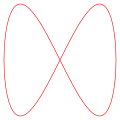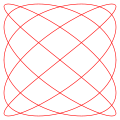The animation below shows the curve adaptation with continuously increasing
 fraction from 0 to 1 in steps of 0.01. (δ=0)
fraction from 0 to 1 in steps of 0.01. (δ=0)Below are examples of Lissajous figures with δ = π/2, an odd natural number a, an even natural number b, and |a − b| = 1.
Generation
Prior to modern electronic equipment, Lissajous curves could be generated mechanically by means of a harmonograph.Practical application
Lissajous curves can also be generated using an oscilloscope(as illustrated). An octopus circuit can be used to demonstrate the waveform images on an oscilloscope. Two phase-shifted sinusoid inputs are applied to the oscilloscope in X-Y mode and the phase relationship between the signals is presented as a Lissajous figure.On an oscilloscope, we suppose x is CH1 and y is CH2, A is amplitude of CH1 and B is amplitude of CH2, a is frequency of CH1 and b is frequency of CH2, so a/b is a ratio of frequency of two channels, finally, δ is the phase shift of CH1.
A purely mechanical application of a Lissajous curve with a=1, b=2 is in the driving mechanism of the Mars Light type of oscillating beam lamps popular with railroads in the mid-1900s. The beam in some versions traces out a lopsided figure-8 pattern with the "8" lying on its side.
Application for the case of a = b

In this figure both input frequencies are identical, but the phase variance between them creates the shape of an ellipse.
 and an aspect ratio of
and an aspect ratio of  (a line) corresponding to a phase shift of 0 or 180 degrees. The figure
below summarizes how the Lissajous figure changes over different phase
shifts. The phase shifts are all negative so that delay semantics can be used with a causal
LTI system (note that −270 degrees is equivalent to +90 degrees). The
arrows show the direction of rotation of the Lissajous figure.
(a line) corresponding to a phase shift of 0 or 180 degrees. The figure
below summarizes how the Lissajous figure changes over different phase
shifts. The phase shifts are all negative so that delay semantics can be used with a causal
LTI system (note that −270 degrees is equivalent to +90 degrees). The
arrows show the direction of rotation of the Lissajous figure.
A pure phase shift affects the eccentricity of the Lissajous oval. Analysis of the oval allows phase shift from an LTI system to be measured.






0 comments:
Post a Comment